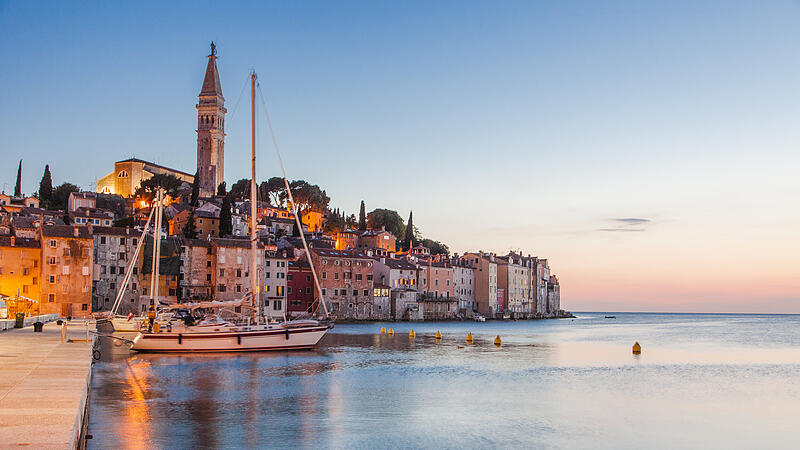Greasy cevapcici and hotel rooms in communist prefab blocks: holidays in Croatia have long been considered less than glamorous. There is no longer any trace of this cheap image in Istria. In addition to the well-known advantages such as the crystal-clear sea and historic cities, the region has established itself as an attractive destination for wine connoisseurs, gourmets and lovers of a relaxed lifestyle.
The fact that the people in Istria have developed their own identity is historically conditioned: Whether Romans, Venetians or Old Austrians ruled – the population of the peninsula always had to settle between down-to-earthness and cosmopolitanism. This also did not change after the world wars, when borders were pushed back and forth seemingly indiscriminately.
noble oil
The Istrians also quickly went their own way in tourism. Individual people are always the key to high quality. Like the olive oil producer Tedi Chiavalon: “At the age of 13, my brother Sandi planted 100 olive trees. That was the beginning of our company. We started tastings in our grandfather’s garage – on 45 square meters.” Back then nobody believed in the young boys. Today, visitors test the duo’s fine oils in a chic showroom, right next to the state-of-the-art, computer-controlled production facility, covering a total of 1,000 square meters. The brothers deliver up to 80,000 bottles of the fine oil to 23 countries, especially to German-speaking countries. “My grandfather would scold us: Back then, he made 25 to 30 liters of olive oil from a hundred kilos of olives. With our cold pressing at 18 to 21 degrees, we get six to nine liters from the same amount of fruit.” But success proves the Chiavalones right: their products have won several awards and are in great demand. “What do you taste?” asks Tedi during the tasting. Little by little, he reveals what makes a good olive oil: the flower has to be green and fruity, while bitterness and spiciness unfold in the mouth. “In combination with other dishes, the oils then taste milder,” promises the enthusiastic entrepreneur, who not only attaches great importance to quality, but also to environmental protection. Everything is 100% recycled during production and the cultivation is close to nature.
Fresh fish – no menu
Hosts like Sergio Jugoslav from Novigrad also contribute to making a visit to Istria a very special experience. In his cult tavern Cok, which is named after the jovial restaurateur, this freshly caught Adriatic fish is served – masterfully and yet minimalistically prepared. Noble tuna tartare or spicy lasgne with fish and scampi tickle the palate. And for dessert, an airy cream cheese cake with pear, topped with a nest of delicate chocolate seaweed, melts in your mouth. Finally there is grappa with sage and honey. What is on the menu depends on the current catch and the mood of the innkeepers. There is no menu, and certainly not with 30 different dishes – and anyone who asks for it will be viewed with some suspicion. What you often encounter in Istria: Rustic tradition meets design. Cok has just invested in a modern, rather offbeat lighting concept for his restaurant and is satisfied with the result. Of course, the concept came from friends.
A few steps away, Sergio Gobbo runs the Gallerion Marine Museum. “Even as a boy I liked to hear stories from fishermen and sailors about the sea and shipping. Since then I’ve been collecting things that have something to do with it,” says the Istrian. In just 200 square meters, the designer and photographer has collected a hodgepodge of relics from two world wars, which he guards like relics. If you like, you can browse through relevant books and squeeze through narrow corridors to examine sailor suits, weapons, ship models and many, many photos.
Things are sophisticated in Rovinj. It doesn’t matter whether it’s the ship-shaped Hotel Lone, which was replicated in Asia, the elegant Mulin or the top chic Grand Park – all large five-star hotels belong to the same owner. The recipe for success: We don’t skimp on design or service. Hotel manager Peter Loesch explains: “I’m not measured by profit, but by whether the quality has stayed the same or improved at the end of the year.” The German has long felt at home in Istria with his family and reveals how freshly caught fish from the Adriatic is served here: “You never find it where there are pictures of food hanging outside. You have to be aware: quality has its drawbacks Price.” Incidentally, the hotelier in Istria has never eaten bad olive oil in three decades.
Those who move away from the city via the wide, bright promenade immerse themselves in wonderful forests that reveal many a botanical surprise. The huge area in the south of the city was laid out by Georg Hütterott at the end of the 19th century.
addresses and tips
Istria Tourist Board: istra.hr
Hotels:
Boutique Hotel Rivalmare: rivalmare.hr
Hotel Monte Mulini: maistra.com
San Canzian Village: san-canzian.hr
Villa Meneghetti: meneghetti.hr
Baracija Manor: baracija.hr
Excursion tips:
Konoba Cok, ul. Sv. Antona 2, 52466 Novigrad
Chiavalon olive oil: chiavalon.hr
Artist town of Groznjan
Limski Fjord
Getting there:
By car from Linz (about six hours) or by plane from Vienna-Schwechat to Pula from mid-May
Source: Nachrichten




